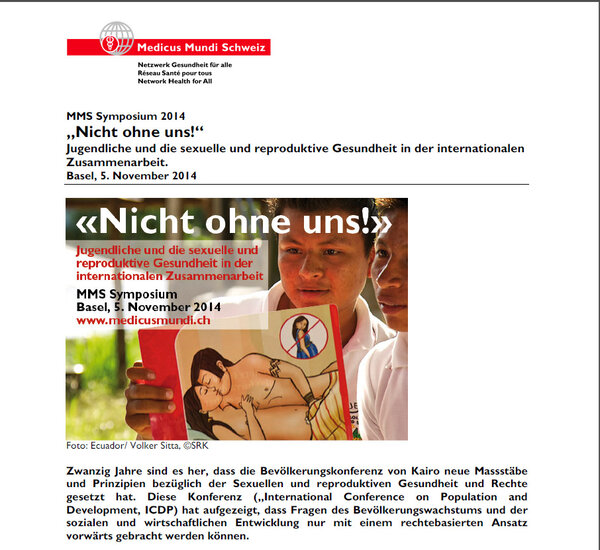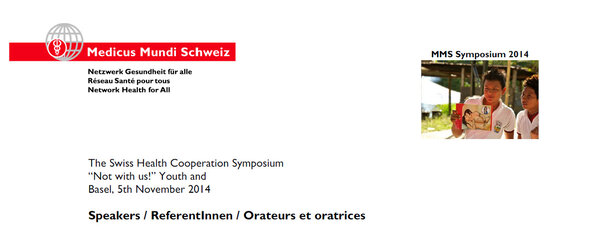- Exchange and Networking
- Knowledge and Learning
- Advocacy
- Our topics

Programme and organisational information as pdf to download.

Short biographical notes about our speakers
WHO Fact Sheet N°364; Udated September 2014
Global overview of adolescents' health and health-related behaviour WHO, 2012
Policy Brief 2012
Adolescents, both unmarried and married, face many sexual and reproductive health risks stemming from early, unprotected, and unwanted sexual activity. Key factors underlying this issue are lack of access to sexuality education, and to accessible, affordable, and appropriate contraception. There is an urgent need to implement programmes to meet the contraception needs of adolescents, while dismantling the current barriers to adolescents from accessing services
WHO guidelines, 2011
The WHO guidelines, Preventing early pregnancy and poor reproductive outcomes among adolescents in developing countries, provide both a call to action and directions for future research on: • preventing early pregnancy: by preventing marriage before 18 years of age; by increasing knowledge and understanding of the importance of pregnancy prevention; by increasing the use of contraception; and by preventing coerced sex; and • preventing poor reproductive outcomes: by reducing unsafe abortions; and by increasing the use of skilled antenatal, childbirth and postnatal care.
WHO, 2012
This Guidebook sets out the public health rationale for making it easier for adolescents to obtain the health services that they need to protect and improve their health and well-being, including sexual and reproductive health services. It defines ‘adolescent-friendly health services’ from the perspective of quality, and provides step-by-step guidance on developing quality standards for health service provision to adolescents. Drawing upon international experience, it is also tailored to national epidemiological, social, cultural and economic realities, and provides guidance on identifying what actions need to be taken to assess whether appropriate standards have been achieved
WHO 2009
This guidebook is designed to assist national and district health managers, as well as managers and staff at health facilities, to assess the quality of their services for adolescents and young people in relation to the list of adolescent-friendly characteristics. This assessment will help managers and staff identify where their services and systems are already “adolescent-friendly” and will suggest where and how improvements can be made
Today's 1.8 billion adolescents are more exposed to harmful alcohol consumption, sexually transmitted diseases, and other risks than in the past, and face other new challenges such as social media. The Lancet's second Series on Adolescent Health, launched to coincide with the 45th Session of the United Nations Commission on Population and Development, argues that it is now time to put the young person, not the specific issue, centre stage. Four papers analyse the role of adolescence as a foundation for future health, the social determinants of adolescent health, the potential of the worldwide application of prevention science, and the current availability of data on 25 suggested core indicators in all countries. • Adolescence: a foundation for future health • Adolescence and the social determinants of health • Worldwide application of prevention science in adolescent health • Health of the world's adolescents: a synthesis of internationally comparable data
George C Patton , David A Ross, John S Santelli, Susan M Sawyer, Russell M Viner, Sabine Kleinert The Lancet, Volume 383, Issue 9915, Pages 385 - 386, 1 February 2014
A quiet revolution has finally brought recognition to the significance of health in the quarter of the world's population who are adolescents and young adults. Three decades of calls for action on adolescent health in policy and in academic publications have substantially increased in intensity in the past 18 months. The reason is simple: adolescents are central to every major current challenge in global health.
Haller DM, Narring F, Chondros P, Pejic D, Sredic A, Huseinagic S, Perone N, Sanci LA, Meynard A. Springerplus. 2014; 3: 319
Young people face many barriers in accessing health services that are responsive to their needs. The World Health Organization has led a call to develop services that address these barriers, i.e. youth-friendly health services. Addressing the needs of young people is one of the priorities of Foundation fami, an organisation working in collaboration with the Swiss Federal Department of Development and Cooperation and Geneva University Hospitals to develop quality family medicine services in Bosnia and Herzegovina. This paper describes the design of a trial to assess the effectiveness of a multifaceted intervention involving family medicine teams (primary care doctors and nurses) to improve the youth-friendliness of family medicine services in Bosnia and Herzegovina.